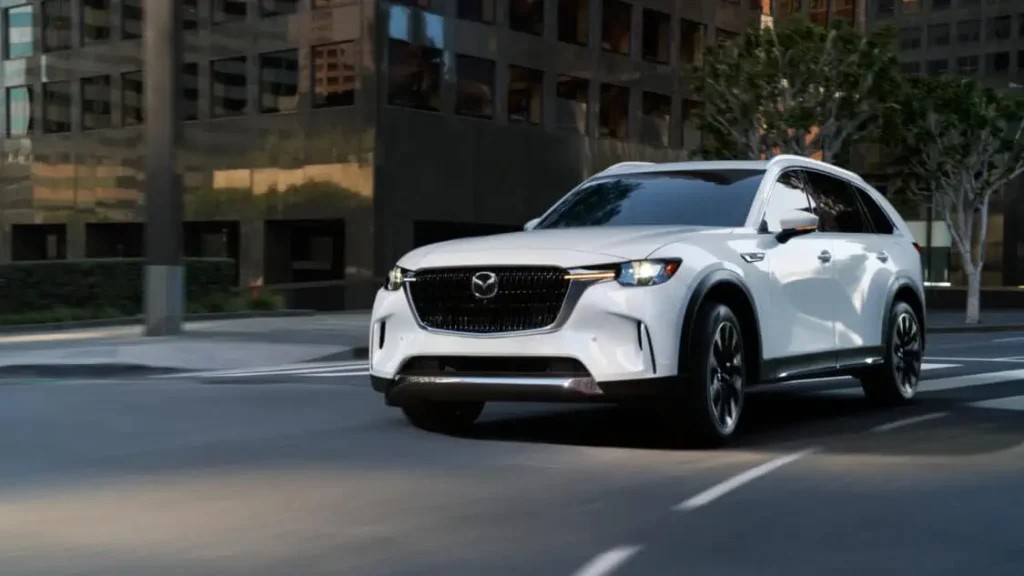Driving Forward: Mazda’s EV Strategy, Lineup, and Toyota Partnership
Producing electric vehicles (EVs) is a gamble and can be difficult for small companies like Japan’s Mazda. In a recent interview, Mazda CEO Masahiro Moro said Mazda will be an “intentional follower” in Mazda’s EV strategy in production space, and will wait and see what customers want before making any electric cars.

Navigating the Road to Mazda’s EV Future: A Strategic Approach
When speaking about the company’s plans for producing EVs, Moro said: “One of the big issues for us is that demand is uncertain. In the current market, the reality for electrification, in particular for battery EVs, is the pace is not that high. So we may start a little slower in terms of the ramp-up. Not necessarily in terms of timing, but the ramp-up.”
A new family of Mazda EVs is coming on a new platform as part of their strategy. The company predicts the Mazda EVs will arrive between 2025 and 2027. The division within Mazda that will produce the EVs is very new, created in November 2023. Moro said the company may produce EVs in the United States beginning in 2028 to be eligible for the clean vehicle tax credit.
Mazda’s EV Transition: From MX-30 to the CX-90 PHEV SUV

Mazda announced in July 2023 that it will stop selling the MX-30 electric SUV in the United States after the 2023 model year. As Mazda’s first mass-produced electric car, The MX-30 is a sporty subcompact crossover SUV. Mazda currently offers it as a battery electric (BEV), plug-in hybrid (PHEV), or mild hybrid (MHEV.) Mazda based the vehicle’s design on the CX-30.
Mazda’s CX-90 PHEV SUV is a standout among 2024 hybrid SUVs. It offers a spacious, comfortable 3-row layout. The Mazda CX-90 PHEV SUV’s electric-only range is 26 miles (EPA-Estimated), with a total range of 490 miles (EPA-Estimated.)
Mazda’s Partnership with Toyota in EV Strategy
Mazda and Toyota partnered, creating the Mazda Toyota Manufacturing (MTM) joint venture. MTM completed building a facility in Huntsville, Alabama, in 2021. The company also has alliances and partnerships with Nissan, Isuzu, Suzuki, and Ford. As of March 2023, Toyota and Mazda have invested $2.311 billion into the MTM venture.

To lower the cost of developing a new EV platform, Mazda will rely on a lot of Toyota’s technology. Beginning in 2026, Mazda says it will use “almost wholesale” Toyota electronics and software. This is a significant saving for Mazda, saving the cost of developing those components.
Moro continued, “There are many things an individual company can’t do alone. In the past, we might have said this is a competitive area. But now, it is a collaborative area.”
Mazda’s Iconic SP Concept, the Return of the Rotary Sportscar
Mazda sports cars have gone through some dramatic changes. These changes focus on a sustainable, lower-emissions, higher-performance future. Released at Japan Mobility Show 2023, the Mazda Iconic SP Concept is understood to be a preview of where the MX-5 is going in the future. So far, the MX-5 has been the best-selling, two-seater convertible sports car in history.
Mazda’s Iconic SP Concept is small, with smooth surfacing, delightful detailing, and great proportions. The car features upward-swinging doors and other innovative features. However, Mazda’s vehicles need to evolve for a cleaner future. In light of this, the Iconic SP Concept features an electric range extender powertrain. The powertrain is similar to the Mazda MX-30 REV. The concept features a two-rotor motor, unlike the MX-30’s single-rotor. The concept offers an impressive total output of 370PS. Mazda’s Iconic SP Concept powertrain works the same way it does in the MX-30. In both cars, the engine’s only function is to charge the batteries. The engine has no physical connection to the powered wheels.
A Featherweight Vehicle Compared to Almost All Other EVs

The concept features a small electric battery and generator engine. Weighing in at 1,450kg, the Iconic SP stays very lightweight, lighter than almost all other electric vehicles. While this is more than the MX-5 or RX sports cars of the past, it is featherweight compared to nearly all other EVs today. Mazda says the weight distribution front to rear is a perfect 50:50. The engine is positioned in the center of the car, resulting in an even weight distribution.
More Hybrid Mazdas Heading to America

In the meantime, many more hybrid Mazdas are on the way to the US. In North America, half of the recently introduced CX-90 sales have been for the plug-in hybrid version. Mazda says a plug-in hybrid variant of the smaller CX-50 is in the works.
Is Mazda’s Hesitation Warranted?
Cutbacks to EV plans for many automakers made the news at the end of 2023. Ford cut back production of its all-electric F-150 Lightning truck, and GM abandoned its plan to build 400,000 electric vehicles through mid-2024.
However, others are going full steam ahead into electric. At the beginning of 2023, Nissan announced its plan to release 23 electrified vehicles, including 15 EVs, by 2030. In August 2023, it announced a ramp-up of its EV campaign, with a release around 2025. The company increased its plans to offer more EVs, with an expected launch of 27 electrified models by 2030, including 19 all-electric vehicles.
With cutbacks by Ford, GM, and others, some are worried that the EV revolution is slowing. Others look at Nissan and other companies that are going ahead even stronger into EVs. This warrants our belief that the cutbacks are surpassed by the increases, causing net gains. Only time will tell; the next few years in the EV industry will be exciting. While there might be some challenges along the way, it’s clear we’re moving towards a future with more electric cars and less pollution.

Electric Vehicle Marketing Consultant, Writer and Editor. Publisher EVinfo.net.
Services